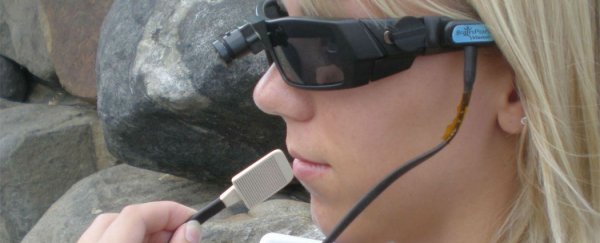Meet the BrainPort V100, a device that's just passed through FDA (Food and Drug Administration) approval in the US, a key milestone before going on sale to users. The gadget, which looks like a tricked-out pair of sunglasses, helps visually impaired users detect what's around them using a small tongue array connected to the specs.
The eyeglasses 'see' what's happening around the wearer and translate this into electrical pulses. After users have learned how to decode these pulses - the same way they might learn to decode braille - they can work out the position and size of objects around them, and even whether they're moving or stationary.
Parent company Wicab describes the BrainPort V100 as a "400-point refreshable braille" device, and says the tongue adaptor feels like "sparkling water or vibrations" on the tongue - using the attached remote control you can adjust the strength of the pulses. Wicab says the technology is most suitable for those who have no useful vision.
You can't just step outside with a pair on though. A minimum of 10 hours training with a certified instructor is required, and the inventors say you're going to need plenty of practice to master the way that the gadget works. The integrated rechargeable battery is good for three hours of use.
It may not be the most intuitive device to use, but it's a high-tech upgrade of the traditional white cane and could provide a new lease of life to those who suffer from impaired vision. It's also the latest in a long line of gadgets opening up new opportunities for those with disabilities or health problems. FDA approval means Wicab can now market the product and work towards getting the BrainPort V100 on sale, though no fixed date has been announced.
According to Alexandra Ossola at Popular Science, the gadget will set buyers back a cool $10,000. It's been six years in development and Wicab reports that 69 percent of test subjects have been able to identify objects using the BrainPort V100 after a year of practice. That's pretty impressive when all you have are pulses on your tongue to go off.
"The BrainPort V100 has been tested by individuals with no usable vision, both congenitally blind and with acquired blindness," says Wicab. The FDA approval ruling says that the device should be used as a complement to a cane or a guide dog - it won't be possible for blind users to rely entirely on the BrainPort V100, but it will give them a better idea of what's around them at all times.
"Medical device innovations like this have the potential to help millions of people," said the FDA's William Maisel as the news was announced. "It is important we continue advancing device technology to help blind Americans live better, more independent lives." Some 1.2 million people in the US were registered as blind in 2010, and that figure is expected to rise to 4.1 million by 2050.
